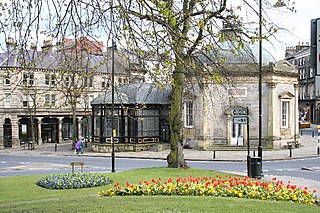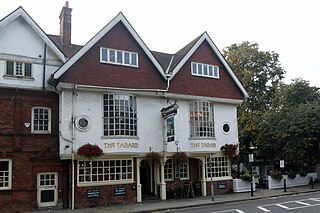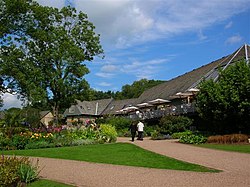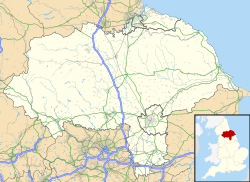
The Royal Horticultural Society (RHS), founded in 1804 as the Horticultural Society of London, is the UK's leading gardening charity.

Harrogate is a spa town in the district and county of North Yorkshire, England. Historically in the West Riding of Yorkshire, the town is a tourist destination and its visitor attractions include its spa waters and RHS Harlow Carr gardens. 13 miles (21 km) away from the town centre is the Yorkshire Dales National Park and the Nidderdale AONB.
Sir Frederick Ernest Gibberd CBE was an English architect, town planner and landscape designer. He is particularly known for his work in Harlow, Essex, and for the BISF house, a design for a prefabricated council house that was widely adopted in post-war Britain.

RHS Garden Wisley is a garden run by the Royal Horticultural Society in Wisley, Surrey, south of London. It is one of five gardens run by the society, the others being Harlow Carr, Hyde Hall, Rosemoor, and Bridgewater. Wisley is the second most visited paid entry garden in the United Kingdom after the Royal Botanic Gardens, Kew, with 1,232,772 visitors in 2019.

Bettys and Taylors of Harrogate is a family-owned company based in Yorkshire, England. Bettys Café tea rooms serve traditional meals with influences from both Switzerland and Yorkshire.

RHS Garden Hyde Hall is a public display garden run by the Royal Horticultural Society in the English county of Essex. It is one of five public gardens run by the society, alongside Wisley in Surrey, Harlow Carr in North Yorkshire, Rosemoor in Devon, and Bridgewater in Greater Manchester.

The Devonshire Dome building is a Grade II* listed 18th-century former stable block in Buxton, Derbyshire. It was built by John Carr of York and extended by architect Robert Rippon Duke, who added what was then the world's largest unsupported dome, with a diameter of 44.2 metres (145 ft). It is now the site of the Buxton Campus of the University of Derby.

Chapel Allerton is an inner suburb of north-east Leeds, West Yorkshire, England, 2 miles (3.2 km) from the city centre.

The Royal Pump Room is a Grade II* listed building in Harrogate, North Yorkshire, England. Today it houses the town's museum – operated by North Yorkshire Council. It was formerly a spa water pump house. It is located in Crown Place in the western part of Harrogate town centre, opposite the town's Valley Gardens park. It is bounded by two streets, Crescent Road and Royal Parade. Today, the Pump Room consists of both the original 1842 stone rotunda and a glazed annexe which was opened in 1913. The Pump Room offered guests of the town an all weather facility where they could drink sulphur water which was pumped on site from a natural spring known as the Old Sulphur Well. The building also had a social element to it as it provided guests with a place to meet friends and get to know others.

The block of three buildings containing The Tabard public house is a Grade II* listed structure in Chiswick, London. The block, with a row of seven gables in its roof, was designed by Norman Shaw in 1880 as part of the community focus of the Bedford Park garden suburb. The block contains the Bedford Park Stores, once a co-operative, and a house for the manager.

The White Hart is a hotel, conference centre and grade II* listed building located in the Montpelier Quarter of Harrogate, North Yorkshire. It has served visitors to the spa town for over 250 years.

RHS Garden Bridgewater is the Royal Horticultural Society's fifth public display garden. It is located in the village of Worsley in Salford, Greater Manchester, England.

Isaac Thomas Shutt was an architect, a farmer, and the proprietor of the Old Swan Hotel, Harrogate, then in the West Riding of Yorkshire, England, from 1849 to 1879. In 1842, at the age of 24 years, he designed the Royal Pump Room, Harrogate, now a Grade II* listed building. In partnership with Alfred Hill Thompson he co-designed the Church of All Saints, Harlow Hill.

Valley Gardens is a grade II listed park in Harrogate, North Yorkshire. The park, which covers 17 acres (6.9 ha), was laid out in 1887 to commemorate the golden jubilee of Queen Victoria.

Bewerley Grange is a historic building in Bewerley, a village in North Yorkshire, in England.
Bewerley Old Hall, also known as the Priest's House, or in the early 20th century as Tudor House, is a historic building in Bewerley, a village in North Yorkshire, in England.

Embsay Manor House is a historic building in Embsay, a village in North Yorkshire, in England.
Grassington Hall is a historic building in Grassington, a town in North Yorkshire, in England.

The Gardeners Arms is a pub in Bilton, a suburb of Harrogate in North Yorkshire.
Harlow Moor is a ward in the town of Harrogate, North Yorkshire, England. It contains 23 listed buildings that are recorded in the National Heritage List for England. Of these, one is listed at Grade I, the highest of the three grades, one is at Grade II*, the middle grade, and the others are at Grade II, the lowest grade. The ward is to the west of the centre of the town, containing part of Low Harrowgate, and the area of Harlow Hill. It is mainly residential, with remnants of the town's history as a spa town. Within the ward are the Valley Gardens and RHS Garden Harlow Carr, both of which contain listed buildings. The other listed buildings include houses, cottages and associated structures, hotels, bridges, churches, an observation tower, a water tower, a set of lamp posts, and a pavilion and colonnade.




















